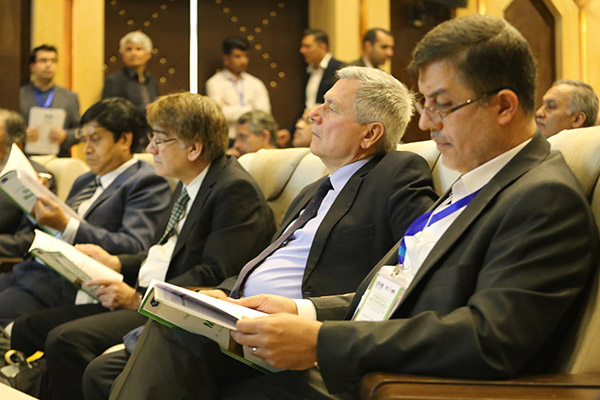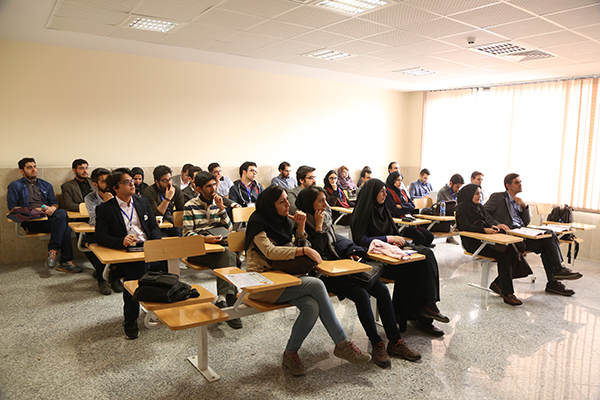
Prof. Philippe Cardou, Laval University

A hint of the ideas that will be discussed.
One of the key advantages of cable-driven parallel robots (CDPRs) over other types of manipulators is their reconfigurability. The modularity of the winch systems that they rely on and their relatively light weight can allow their rapid deployment and the modification of their geometry. In order to fully take advantage of this characteristic, it would be interesting to provide the CDPR operator with an algorithm that can take as an input the desired workspace and related environmental constraints and return the best corresponding CDPR geometry.
To this end, we first review the mathematical expressions of the wrench-feasible workspace of CDPRs and their collision-free workspace. We then show how these expressions can be included in the standard form of a nonlinear programming problem. Two formulations of such problems will be reviewed: one involving convex relaxations over boxes inside the workspace and the other involving a simpler discretisation thereof. Examples will be provided to illustrate and assess the usefulness of both methods.

Prof. Hamid D. Taghirad, K. N. Toosi University of Technology
Cable and parallel robotics have been gaining more attention among researchers due to their unique characteristics and applications. Simple structure, high payload capacity, agile movements, and simple structures are the main characteristics that nominate cable-robots from the other types of manipulators for many applications such as imaging, cranes, agriculture, etc. The ARAS Parallel and Cable Robotics (PACR) group is focused on the development of such novel manipulators and their possible applications. Interdisciplinary research fields such as dynamics and kinematic analysis using classic and modern approaches, development of easily deployable robots thorough robust controllers, implementation of novel self-calibration algorithms, and establishing modern and multi-sensor perception systems for them are among the active lines of research in this group. In this workshop a brief overview of these advancement is introduced, and some commercial products through the spin-off and startup companies originated from the team is explained. Kamalolmol® robot is a representative of such products, which is a fast deployable edutainment cable-driven robot for calligraphy and painting (chiaroscuro) applications. The parallelogram structure used in the cable structure of the system, which will significantly increase the speed of this robot will be given more attention.

Dr. Darwin Lau, The Chinese University of Hong Kong
Cable-driven robots have been studied in recent years due to its unique characteristics and advantages. As a result, they have been used in a wide range of applications from large-scale manipulation, bio-inspired robots to rehabilitation. From modelling, dynamics, control and workspace analysis, there exists many difficult challenges due to the characteristic that cables can only pull and not push. Despite its recent popularity and attractive advantages, the use of cable-driven robots in the real-world is only slowly gaining traction. In this presentation, the relationship between fundamental developments and practical application will be presented. This will include the generalised modelling framework, software development for cable-driven robots, and the development of new control and analysis techniques, and ultimately its usage within applications such as building construction, bio-inspired robots and service maintenance.

Prof. Marco Carricato, Department of Industrial Engineering, University of Bologna, Italy

Edoardo Idà, Department of Industrial Engineering, University of Bologna, Italy

Cable-Driven Parallel Robots (CDPRs) are parallel robots that use cables in place of rigid extensible legs to move the end-effector (EE). CDPRs present specific advantages over traditional parallel robots, such as remarkably large workspaces. Since guaranteeing positive tensions in cables is a necessary requisite to control the pose of the robot, the unilateral constraints imposed by cables complicate the system control.
CDPRs equipped with a limited number of cables may be favorable to use in several applications, in which the task to be performed requires a limited number of controlled freedoms, or a limitation of mobility is acceptable to enhance accessibility, decrease complexity, and ultimately cost. However, underactuated CDPRs are intrinsically underconstrained, since their EE is subject to fewer constraining actions than the number of EE DoFs. Consequently, the EE preserves some freedoms, and its pose cannot be prescribed entirely. In addition, once the actuators are locked, EE natural oscillations may arise, a condition that is referred to as free motion.
Our speech focuses on the geometrico-static and free motion modeling of underactuated cable- driven parallel robots, and their application to equilibrium identification, stability analysis, trajectory planning, and parameter identification.

Stéphane Caro, National Centre for Scientific Research (CNRS)
Cable-Driven Parallel Robots (CDPRs) form a particular class of parallel robots whose moving platform is connected to a fixed base frame by cables. The connection points between the cables and the base frame are referred to as exit points. The cables are coiled on motorized winches. Passive pulleys may guide the cables from the winches to the exit points. A central control system coordinates the motors actuating the winches. Thereby, the pose and the motion of the moving platform are controlled by modifying the cable lengths. CDPRs have several advantages such as a relatively low mass of moving parts, a potentially very large workspace due to size scalability, and reconfiguration capabilities. Therefore, they can be used in several applications, e.g. heavy payload handling and airplane painting, cargo handling, warehouse applications, large-scale assembly and handling operations, and fast pickand- place operations. Other possible applications include the broadcasting of sporting events, haptic devices, support structures for giant telescopes, and search and rescue deployable platforms. This keynote will deal with the design, modeling, workspace analysis and control of CDPRs. A focus will be put on the development of CDPRs in Nantes, France, and their potential industrial applications.

Prof. Tobias Bruckmann, University of Duisburg-Essen
Construction is a field still dominated by manual work. Several approaches to introduce automated systems have been proposed, and currently numerous initiatives are developing demonstrators and prototypes. However, it is still a challenge for conventional robots to realize construction tasks since – among other issues – the pure volume of a construction project is hard to cover.
Here, Cable-Driven Parallel Robots show relevant advantages. They can realize extremely large workspaces, are configurable and can be erected easily using lightweight modular elements. It is even conceivable to realize CDPR using a climbing frame to address multi-storey buildings. Clearly, these developments are only reasonable if digital building models are available which where became rapidly popular during the last few years in the context of Building Information Modeling (BIM).
The talk addresses ongoing projects at the University of Duisburg-Essen that aim at realizing automated construction using CDPR. Besides virtual models and simulation tools, the realized demonstrators are presented.

Dr. Mohammad A. Khosravi, Amirkabir University of Technology
In recent decades, the growing need of industry for high-speed robots with a large workspace has led to the development of cable-driven parallel robots (CDPR). Having significantly lower inertia than the rigid linkage robots makes CDPRs a unique alternative for applications with large workspace requirements and high-speed manipulation demands. However, by cables we may exert only tensile force in pulling direction. The positive tensile force of the cables in CDPRs is guaranteed either through a passive force, such as gravity, or using redundant cables in their structure. This challenge motivates the researchers to develop desirable control algorithms for a CDPR to maintain positive tension in all the cables while having a suitable tracking performance. This talk addresses the control challenges in CDPRs and discusses some approaches that suitably employed for this class of robots. In particular, the first part of the talk demonstrates the CDPRs kinematics and their different types of workspace as well as their dynamics. The second part of the talk focuses on control challenges of the CDPRs and next, some solutions are introduced. At the end, ongoing and future direction in the control of the CDPRs will be discussed.

Dominique Martinez, LORIA, a computer science laboratory in Nancy, France
In this talk, I will describe an application of cable-driven parallel robots (CDPRs) to insect flight research. The flight mechanics of insects and their sensorimotor system have fascinated scientists for a very long time. Yet, studying them experimentally is difficult because of the small size of insects and their high speed of motion. Consequently, previous studies were limited to tethered flights, hovering flights, or restricted flights within confined laboratory chambers. Here, I will report the development of a CDPR, named lab-on-cables, for tracking and interacting with a free-flying insect. In this approach, cameras are mounted on cables, so as to move automatically with the insect. We validated the lab-on-cables with Agrotis ipsilon moths (ca. 2 centimeters long) flying freely up to 3 meters per second. The analysis of flight kinematics is consistent with a helicopter model of insect flight, whereby flight speed is controlled by body pitch via changes in the stroke plane angle.



